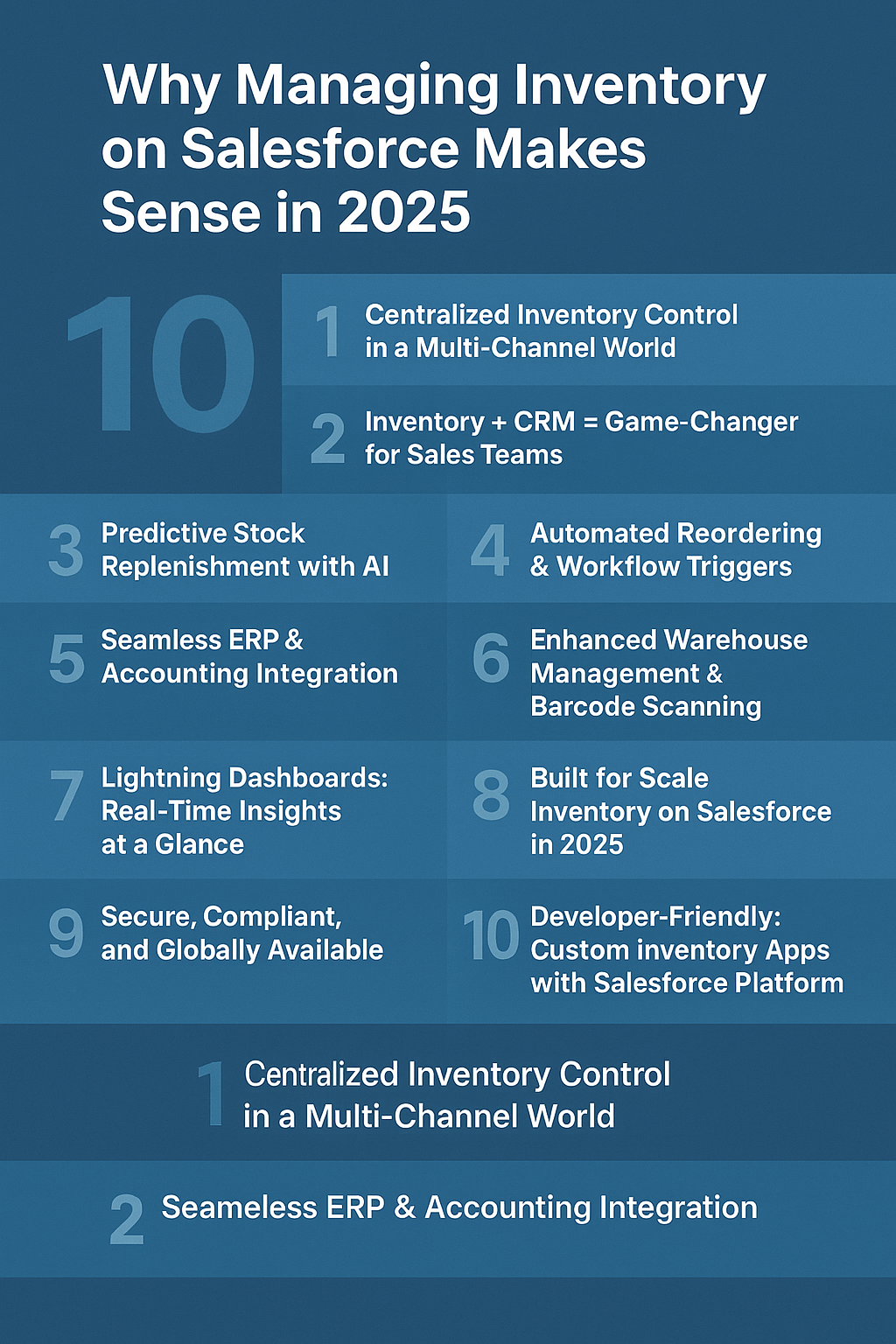
In today’s fast-paced business landscape, Inventory on Salesforce is rapidly becoming the go-to solution for companies that demand real-time data, seamless integrations, and centralized operations. Whether you’re running an eCommerce store, managing complex MedTech logistics, or orchestrating global manufacturing operations, Salesforce offers a powerful platform for inventory visibility, automated workflows, and intelligent forecasting.
Let’s explore why managing inventory on Salesforce makes perfect sense in 2025, especially for future-forward companies aiming for scalable, data-driven operations.
1. Centralized Inventory Control in a Multi-Channel World
Inventory fragmentation across multiple systems is a common bottleneck for growing businesses. Salesforce solves this with a centralized inventory layer, accessible via its cloud infrastructure. Businesses can now track stock across:
- Multiple warehouses
- Retail outlets
- eCommerce storefronts
- Dropshipping networks
Having Inventory on Salesforce means all departments—from sales and customer service to logistics—work off a single source of truth.
Use Case: eCommerce
Imagine an eCommerce company selling across Shopify, Amazon, and its own branded store. Salesforce syncs real-time inventory levels, ensuring no overselling, understocking, or fulfillment errors.
Check out this inventory solution on AppExchange ›
2. Inventory + CRM = Game-Changer for Sales Teams
Salesforce’s core strength lies in its CRM. Integrating inventory data within CRM workflows means sales reps instantly know what’s in stock, when restocks are due, and what backorders are pending—all within the same interface.
Benefits include:
- Reduced customer wait times
- More accurate delivery estimates
- Automated reordering triggers
For B2B industries like manufacturing, this is especially critical. Real-time inventory visibility shortens sales cycles and strengthens vendor relationships.
3. Predictive Stock Replenishment with AI
With Einstein AI integrated, Inventory on Salesforce goes beyond real-time tracking. It predicts demand spikes, suggests replenishment orders, and alerts teams about low inventory based on:
- Seasonal trends
- Customer behavior
- Purchase history
This is key for sectors like MedTech, where stockouts can literally cost lives.
Use Case: MedTech
A supplier of surgical equipment uses Salesforce to monitor supply chain data. AI-powered forecasting helps ensure critical inventory (e.g., ventilators or surgical tools) is always available when hospitals need it.
4. Automated Reordering & Workflow Triggers
Thanks to Flow Builder and Process Builder, Salesforce users can automate key inventory processes:
- Reordering when thresholds are reached
- Alerting warehouse teams about incoming stock
- Notifying sales reps of changes in availability
- Syncing order updates to ERP or accounting systems
Such automation is vital in 2025, where lean staffing models rely on efficiency, not manual data entry.
5. Seamless ERP & Accounting Integration
Inventory doesn’t live in a silo. With native integrations to platforms like NetSuite, SAP, and QuickBooks, Salesforce ensures your inventory, sales, finance, and procurement teams operate in sync.
This creates a 360° operational view—essential for CFOs, procurement managers, and operations leads alike.
6. Enhanced Warehouse Management & Barcode Scanning
Managing physical goods? Salesforce supports warehouse management, picking/packing workflows, and barcode scanning via mobile apps.
Use Case: Manufacturing
A mid-sized manufacturing firm uses Salesforce-integrated mobile scanners on their factory floor. Products are scanned in real-time, inventory is automatically updated, and data is shared with procurement teams and shipping departments—all in one ecosystem.
7. Lightning Dashboards: Real-Time Insights at a Glance
With Lightning Dashboards and Reports, users can visualize inventory KPIs such as:
- Top-selling SKUs
- Aged inventory
- Warehouse performance
- Forecast accuracy
Dashboards can be customized by user role—executives get high-level metrics, while warehouse teams get real-time stock movement.
8. Built for Scale: Inventory on Salesforce in 2025
As of 2025, Salesforce’s ecosystem supports more third-party logistics (3PL), marketplace, and eCommerce integrations than ever before.
That means businesses can plug in:
- Shopify
- Magento
- WooCommerce
- Amazon FBA
- FedEx, UPS, and DHL
…and have inventory synced across platforms with zero manual updates.
Explore this AppExchange listing for inventory tools ›
9. Secure, Compliant, and Globally Available
Security and compliance are no longer optional. Salesforce delivers:
- Role-based access
- Multi-factor authentication
- SOC 2, HIPAA, and GDPR compliance
- Global data center availability
Perfect for regulated industries like MedTech and global manufacturers.
10. Developer-Friendly: Custom Inventory Apps with Salesforce Platform
Want to extend or customize inventory workflows? Salesforce provides developers with:
- Apex programming
- REST & SOAP APIs
- Custom objects
- AppExchange components
This makes it easy to build inventory apps tailored to your business model, whether it’s just-in-time delivery or bulk fulfillment.
Final Thoughts
From real-time visibility to AI-based forecasting and ERP integration, Inventory on Salesforce is redefining how businesses manage stock in 2025. Whether you’re shipping daily in eCommerce, distributing life-saving MedTech equipment, or coordinating complex B2B manufacturing flows—Salesforce provides a scalable, intelligent, and secure solution.

